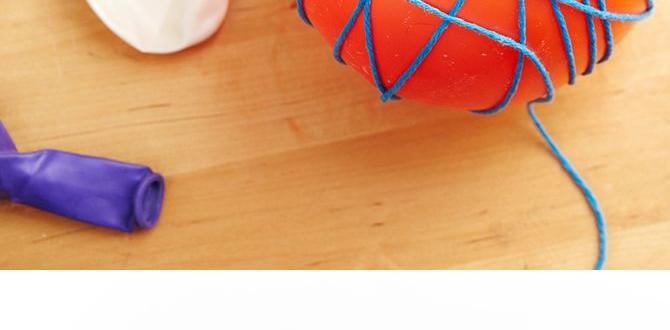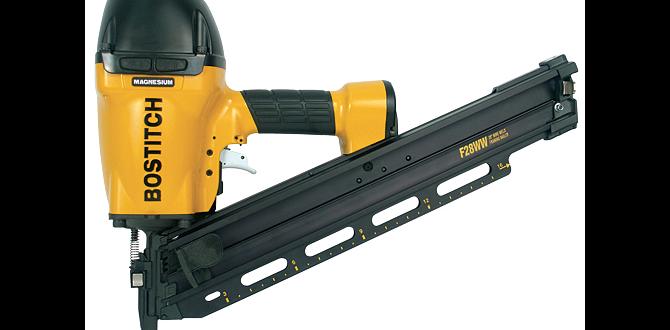When working with a framing nailer, prioritizing safety means understanding your tool, wearing protective gear, and handling it correctly. This guide covers essential tips to ensure you stay safe and productive, preventing injuries and workplace accidents.
Hey folks, Jack Shaffer here from Nailerguy! Ever looked at a framing nailer and felt a little intimidated? They’re powerful tools, and for good reason – they make framing walls and structures a breeze. But with great power comes the need for great caution. Many DIYers, especially when just starting out, aren’t sure about the best safety practices. This can lead to accidents that are easily avoidable. Don’t worry, though! We’re going to walk through everything you need to know, step-by-step, to use your framing nailer safely and confidently. Getting this right means you can focus on your project, not on a trip to the emergency room. Let’s dive into how to keep yourself and everyone around you safe!
Table of Contents
Understanding Your Framing Nailer is Key to Safety
Before you even think about firing a nail, it’s crucial to understand the tool in your hands. Framing nailers are designed for heavy-duty tasks, and their power means they demand respect. Each nailer has its own quirks and features, so taking the time to learn them pays off big time in safety.
Read the Manual (Seriously!)
I know, I know. Manuals can seem dry and technical. But your framing nailer’s manual is packed with vital information specific to your model. It details maintenance, troubleshooting, and, most importantly, safety precautions. It’s the first and best resource for understanding how your tool works and what to avoid.
Know Your Nailer’s Firing Modes
Most framing nailers offer different firing modes. These are usually controlled by a trigger switch or lever. The two main modes are:
- Sequential Firing (or Single-Shot Mode): This is the safest mode for most situations. You must fully depress the workpiece contact (the safety tip on the nose of the nailer) AND then pull the trigger to fire one nail. To fire another nail, you have to release and re-pull the trigger. This prevents accidental firings.
- Contact Firing (or Bump Fire Mode): In this mode, you can fire multiple nails by holding down the trigger and “bumping” the workpiece contact against your material. While faster, it significantly increases the risk of accidental discharge if not used with extreme care and awareness. It’s usually best for experienced users who need speed.
Always start with sequential firing until you are completely comfortable and understand the risks and benefits of contact firing. For beginners, sequential firing is highly recommended.
Air Pressure and Nail Compatibility
If you’re using a pneumatic framing nailer, the air compressor setting is critical. Too much pressure can damage the tool, fire nails at excessive speeds, or cause injury. Too little pressure won’t drive nails effectively. Your manual will specify the recommended PSI (pounds per square inch) range for your nailer. Always check and adjust your air compressor to be within this range. Also, ensure you’re using the correct size and type of nails for your nailer. Mismatched nails can jam the tool, causing dangerous malfunctions.
Essential Personal Protective Equipment (PPE) for Framing Nailer Use
This is non-negotiable, folks. Wearing the right gear is your first line of defense against injuries. Think of PPE as your project’s safety uniform! You wouldn’t go into battle without armor, right? Same with using a framing nailer.
Eye Protection: The Most Crucial Gear
Flying debris, nails, or even parts of the tool can cause severe eye injuries. Always wear safety glasses or goggles that meet the American National Standards Institute’s (ANSI) Z87.1 standards. Make sure they fit snugly and don’t obstruct your vision. If you’re working in a dusty environment, goggles are a better choice.
Hearing Protection: Protect Your Ears
Framing nailers are LOUD. Repeated exposure to loud noises can cause permanent hearing damage. Wear earplugs or earmuffs specifically designed to reduce noise levels. Earmuffs often offer a higher level of protection and are convenient if you need to take them off and put them back on frequently.
Gloves: Grip and Guard
Work gloves are essential for several reasons. They improve your grip on the nailer, reducing the chance of it slipping. They also protect your hands from splinters, cuts, and abrasions when handling lumber. Look for gloves that offer good dexterity so you can still operate the tool comfortably.
Footwear: Sturdy and Safe
Always wear sturdy, closed-toe work boots, preferably with steel toes. This protects your feet from dropped tools, materials, and stray nails. The soles should provide good traction to prevent slips on job sites.
Respiratory Protection (When Needed)
If you’re working with treated lumber or in a particularly dusty environment, consider a dust mask or respirator. Some treated woods contain chemicals that can be harmful if inhaled. Always check the material safety data sheet (MSDS) for any lumber you’re working with if you have concerns.
Safe Handling and Operation of Your Framing Nailer
Beyond PPE, how you physically handle the nailer makes a huge difference. These practices ensure the tool is used as intended and minimize risks.
Maintain a Secure Grip
Always maintain a firm, two-handed grip on the nailer when possible, especially when you’re positioning it for a shot. This gives you better control and stability.
Never Point the Nailer at Yourself or Others
This might seem obvious, but it’s worth repeating. Never point the nailer at any part of your body or at another person, even if you believe it’s not loaded or the air is disconnected. Accidental discharges can happen.
Ensure Proper Workpiece Contact
Before firing, firmly press the workpiece contact (the safety tip at the nose of the nailer) against the material you intend to nail. This is a critical safety feature designed to prevent accidental firing. Don’t force the nailer into the wood; let the tool do the work.
Be Aware of Your Surroundings
Always consider where the nail will go after it passes through your workpiece. Is there someone or something behind it that could be hit by an over-penetrating nail? Ensure the nailing surface is solid and that you’re not firing into thin air or towards an occupied area. Even nails that bend can ricochet.
Proper Stance and Balance
Make sure you have stable footing before firing the nailer. A solid stance helps you maintain control and avoid losing balance, which could lead to an accident. Avoid working on unstable surfaces or in awkward positions.
Disconnect When Not in Use
When you are done using the nailer, or even when taking a short break, disconnect the air hose (for pneumatic tools) or remove the battery (for cordless tools). This removes the power source and prevents accidental firings if the trigger is bumped.
Maintenance and Storage: Keeping Your Nailer Safe and Ready
A well-maintained tool is a safer tool. Regular checks and proper storage can prevent malfunctions and prolong the life of your framing nailer.
Regular Cleaning
Keep your nailer clean, especially the nose piece and the area around the firing mechanism. Sawdust and debris can interfere with the tool’s operation. Refer to your manual for specific cleaning instructions.
Lubrication (Pneumatic Nailers)
Pneumatic nailers require regular lubrication to function smoothly. Use only the recommended air tool oil. Add a few drops through the air inlet before each day’s use or as specified in the manual. Over-oiling can cause issues, so follow the manufacturer’s guidelines.
Inspect for Damage
Before each use, visually inspect your nailer for any signs of damage. Check the housing, cord (if electric), air hose connection (if pneumatic), and especially the safety contact tip. If you find any damage, do not use the tool until it has been inspected and repaired by a qualified technician.
Proper Storage
Store your framing nailer in a clean, dry place. Protect it from moisture, extreme temperatures, and physical damage. Never store it with the air hose connected or battery in place. If it has a carrying case, use it.
Troubleshooting Common Framing Nailer Issues Safely
Sometimes, things just don’t go as planned. Knowing how to safely address common problems can prevent them from becoming bigger issues.
Jamming
Nail jams are common. The first and most important step is to IMMEDIATELY disconnect the power source (air or battery). Never try to clear a jam while the tool is powered. Consult your manual for specific jam-clearing procedures for your model. Usually, it involves removing a few screws to access the magazine or nose piece.
Nails Not Firing
If nails aren’t firing, check the power source (air pressure or battery charge). Ensure the magazine is loaded correctly and the nails are aligned. Check that the workpiece contact surface is being properly depressed. Again, with the power disconnected, inspect the nose piece for any blockages or debris.
Nails Not Driving Fully
This is often an issue with air pressure. For pneumatic nailers, increase the PSI slightly, staying within the recommended range. For cordless nailers, ensure the battery is fully charged. Sometimes, a dull driver blade or a worn o-ring can also cause this issue, requiring professional servicing.
Advanced Safety Considerations
Once you’re comfortable with the basics, keep these advanced tips in mind to further enhance your safety.
Working with Others
If you have a helper, ensure they are aware of your nailing direction and keep a safe distance. They should also be wearing appropriate PPE. Establish clear communication signals.
Working at Heights
When working on scaffolding, ladders, or roofs, maintaining balance is even more critical. Secure your footing and consider a lanyard or strap to tether the nailer to your person or the scaffolding to prevent it from falling if dropped.
Electrical Nailers and Cords
If using an electric framing nailer, be mindful of the power cord. Ensure it’s not in your line of fire, not a tripping hazard, and not in contact with moisture or sharp objects that could cut through the insulation. Always use a Ground Fault Circuit Interrupter (GFCI) outlet.
Battery-Powered Nailers
Familiarize yourself with battery safety guidelines for your specific tool. Store batteries correctly, avoid extreme temperatures, and use only the approved charger.
Comparison: Pneumatic vs. Cordless Framing Nailers – Safety Differences
While both types are powerful, there are slight safety nuances:
| Feature | Pneumatic Nailer Safety Considerations | Cordless Nailer Safety Considerations |
|---|---|---|
| Power Source | Requires air hose connection. Risk of hose kinking, tripping hazard, or sudden air release if connection fails. Ensure secure couplings. | Battery-powered. Risk of battery malfunction or overcharging if not using manufacturer-approved charger. Ensure battery is properly seated. |
| Weight | Can be lighter tool, but the hose and compressor add weight and bulk to the setup. | Tool itself can be heavier due to motor and battery. Less setup bulk. |
| Control | Generally consistent power delivery. | Power can sometimes fluctuate with battery levels. |
| Primary Risk | Air pressure management, hose integrity, tripping hazards. | Battery health and charging protocols, tool weight management. |
Regardless of the type, the fundamental safety principles of PPE, proper handling, and situational awareness remain paramount.
When NOT to Use Your Framing Nailer
Sometimes, the safest action is to put the tool down. Here are a few scenarios to avoid:
- When you are tired or distracted: Fatigue and distraction are huge contributors to accidents. If you’re not feeling 100%, take a break or postpone the task.
- When under the influence: Never operate power tools if you are under the influence of alcohol or any substances that impair judgment or reaction time.
- In wet conditions: Especially for electric models, water and electricity are a dangerous mix. Pneumatic tools can also be affected by extreme moisture for certain components.
- If raining or exposed to elements: Most framing nailers are not designed for outdoor use in adverse weather.
- When the tool is malfunctioning: Don’t try to push through if your nailer is acting up. It’s a sign something is wrong, and using it could be dangerous.
Frequently Asked Questions About Framing Nailer Safety
Q1: What is the most common injury when using a framing nailer?
A1: The most common injuries are nail gun-related injuries to hands and fingers from accidental discharge, followed by eye injuries from flying debris. Proper PPE and sequential firing mode significantly reduce these risks.
Q2: Can a framing nailer shoot through bone?
A2: Yes, a framing nailer is powerful enough to penetrate flesh and bone, causing severe and potentially life-altering injuries. This is why extreme caution and proper technique are stressed.
Q3: How do I safely clear a nail jam?
A3: Always disconnect the power source (air or battery) first. Then, consult your tool’s manual for specific jam-clearing instructions. Never attempt to clear a jam while the tool is live.
Q4: Is it okay to use a framing nailer one-handed?
A4: It’s generally not recommended. A firm, two-handed grip provides much better control, stability, and reduces the risk of accidental firing. If you must use it one-handed, exercise extreme caution and ensure you have excellent balance.
Q5: How often should I lubricate my pneumatic framing nailer?
A5: As a general rule, add a few drops of air tool oil to the air inlet before each day’s use or after about 500 shots. Always refer to your specific tool’s manual for the manufacturer’s recommended lubrication schedule.
Q6: What’s the difference between sequential and contact firing modes, and which is safer?
A6: Sequential firing requires pressing the workpiece contact tip and pulling the trigger for each nail. Contact firing allows rapid firing by holding the trigger down and bumping the tip. Sequential firing is significantly safer for beginners and for most general use as it greatly reduces the risk of accidental discharge.
Conclusion: Safety First, Always!
So there you have it! Using a framing nailer can be incredibly productive and rewarding for your DIY projects, but it’s crucial to approach it with respect for its power. By reading your manual, always using the right PPE, understanding your tool’s firing modes, and maintaining safe operating procedures, you’re setting yourself up for success. Think of safety not as a chore, but as an essential part of good craftsmanship. A little extra time spent on safety precautions can save you a lot of pain, downtime, and potential medical bills. Stay safe out there, keep those projects moving, and happy building!




